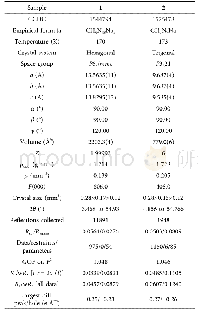《Table 1Crystal data and structure refinement details of CPs 1 and 2》
 提示:宽带有限、当前游客访问压缩模式
提示:宽带有限、当前游客访问压缩模式
本系列图表出处文件名:随高清版一同展现
《多齿五唑N_5~-的自组装纳米含能配位聚合物(英文)》
The prepared CPs are analyzed by single-crystal XRD as shown in Table 1.Polymer 1 crystallizs into a 3D porous metal–inorganic framework with hexagonal crystal system and belongs to the P63/mmc space group.Here the polymer 1 represents a negatively charged structure,because sometimes charge-balancing cations in the cages is irregular and cannot be directly located in the crystal structure analysis.The detailed crystallographic data are provided in Supplementary Tables S1–S3.As depicted in Fig.1,each sodium center Na(I)is hexahedral linked to pentazole linkers(Na–N bond length 2.462–2.499?),involving aη1-bonding-type coordination.There are two types of pentazole rings in polymer 1.The first type is one N5ring attached to three Na(I)ions with coordination angle of~90 and 140°(Na-N5-Na),analogous to imidazolate rings in zeolite-imidazolate frameworks(ZIFs).The N atoms in these N5rings are not completely coplane,with N1-N2-N3-N4 and N1-N5-N4-N3 torsion angles of 0.5°and 0.7°,respectively.The second type is one N5ring attached to four Na(I)ions with coordination angle of~150°(Na-N5-Na).These N5rings and Na(I)are of perfect planarity and the plane is perpendicular to c axis.Moreover,the N5rings in both types do not have identical N–N bond lengths with average values found to be 1.316 and 1.320?respectively.Through these connection modes,8 Na(I)ions and 9 N5rings stitch into a cage of a~7.5?diameter cavity with guanidine cation[C(NH2)3]+placed in it.The cage as a repeat unit is further extended into microporous zeolite-like 3D framework with SOD topology(Fig.1c).Upon removal of guest molecules,the structure of polymer 1 has a porosity of~35%,as calculated with PLATON software[36].
| 图表编号 | XD0039959200 严禁用于非法目的 |
|---|---|
| 绘制时间 | 2019.01.01 |
| 作者 | 王鹏程、许元刚、王乾、邵艳丽、林秋汉、陆明 |
| 绘制单位 | School of Chemical Engineering, Nanjing University of Science and Technology、School of Chemical Engineering, Nanjing University of Science and Technology、School of Chemical Engineering, Nanjing University of Science and Technology、School of Chemical Engin |
| 更多格式 | 高清、无水印(增值服务) |





